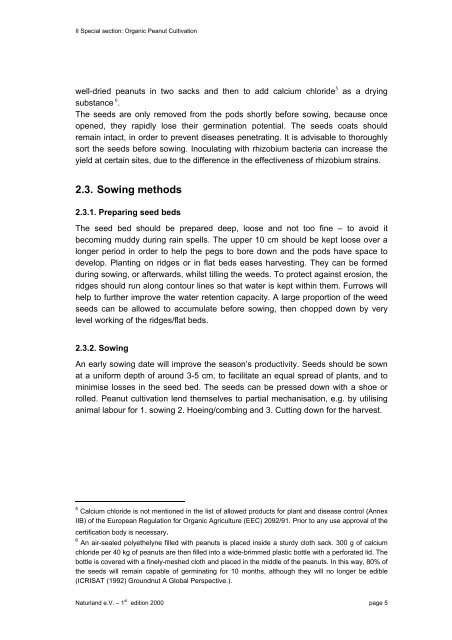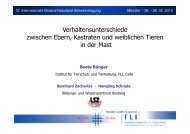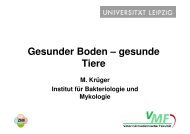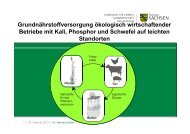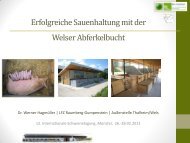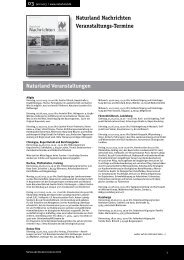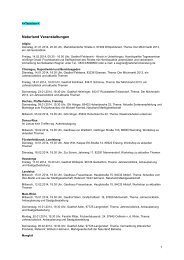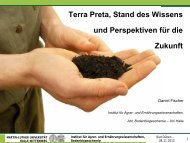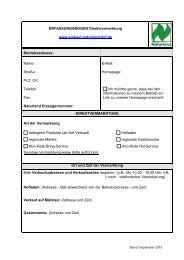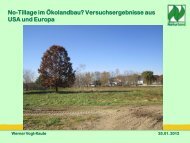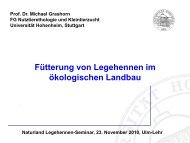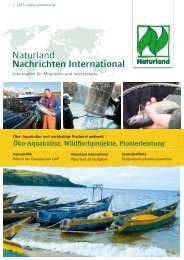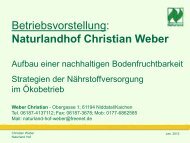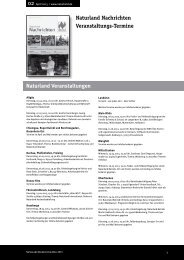Organic Farming in the Tropics and Subtropics: Peanuts - Naturland
Organic Farming in the Tropics and Subtropics: Peanuts - Naturland
Organic Farming in the Tropics and Subtropics: Peanuts - Naturland
You also want an ePaper? Increase the reach of your titles
YUMPU automatically turns print PDFs into web optimized ePapers that Google loves.
II Special section: <strong>Organic</strong> Peanut Cultivation<br />
well-dried peanuts <strong>in</strong> two sacks <strong>and</strong> <strong>the</strong>n to add calcium chloride 5 as a dry<strong>in</strong>g<br />
substance 6 .<br />
The seeds are only removed from <strong>the</strong> pods shortly before sow<strong>in</strong>g, because once<br />
opened, <strong>the</strong>y rapidly lose <strong>the</strong>ir germ<strong>in</strong>ation potential. The seeds coats should<br />
rema<strong>in</strong> <strong>in</strong>tact, <strong>in</strong> order to prevent diseases penetrat<strong>in</strong>g. It is advisable to thoroughly<br />
sort <strong>the</strong> seeds before sow<strong>in</strong>g. Inoculat<strong>in</strong>g with rhizobium bacteria can <strong>in</strong>crease <strong>the</strong><br />
yield at certa<strong>in</strong> sites, due to <strong>the</strong> difference <strong>in</strong> <strong>the</strong> effectiveness of rhizobium stra<strong>in</strong>s.<br />
2.3. Sow<strong>in</strong>g methods<br />
2.3.1. Prepar<strong>in</strong>g seed beds<br />
The seed bed should be prepared deep, loose <strong>and</strong> not too f<strong>in</strong>e – to avoid it<br />
becom<strong>in</strong>g muddy dur<strong>in</strong>g ra<strong>in</strong> spells. The upper 10 cm should be kept loose over a<br />
longer period <strong>in</strong> order to help <strong>the</strong> pegs to bore down <strong>and</strong> <strong>the</strong> pods have space to<br />
develop. Plant<strong>in</strong>g on ridges or <strong>in</strong> flat beds eases harvest<strong>in</strong>g. They can be formed<br />
dur<strong>in</strong>g sow<strong>in</strong>g, or afterwards, whilst till<strong>in</strong>g <strong>the</strong> weeds. To protect aga<strong>in</strong>st erosion, <strong>the</strong><br />
ridges should run along contour l<strong>in</strong>es so that water is kept with<strong>in</strong> <strong>the</strong>m. Furrows will<br />
help to fur<strong>the</strong>r improve <strong>the</strong> water retention capacity. A large proportion of <strong>the</strong> weed<br />
seeds can be allowed to accumulate before sow<strong>in</strong>g, <strong>the</strong>n chopped down by very<br />
level work<strong>in</strong>g of <strong>the</strong> ridges/flat beds.<br />
2.3.2. Sow<strong>in</strong>g<br />
An early sow<strong>in</strong>g date will improve <strong>the</strong> season’s productivity. Seeds should be sown<br />
at a uniform depth of around 3-5 cm, to facilitate an equal spread of plants, <strong>and</strong> to<br />
m<strong>in</strong>imise losses <strong>in</strong> <strong>the</strong> seed bed. The seeds can be pressed down with a shoe or<br />
rolled. Peanut cultivation lend <strong>the</strong>mselves to partial mechanisation, e.g. by utilis<strong>in</strong>g<br />
animal labour for 1. sow<strong>in</strong>g 2. Hoe<strong>in</strong>g/comb<strong>in</strong>g <strong>and</strong> 3. Cutt<strong>in</strong>g down for <strong>the</strong> harvest.<br />
5 Calcium chloride is not mentioned <strong>in</strong> <strong>the</strong> list of allowed products for plant <strong>and</strong> disease control (Annex<br />
IIB) of <strong>the</strong> European Regulation for <strong>Organic</strong> Agriculture (EEC) 2092/91. Prior to any use approval of <strong>the</strong><br />
certification body is necessary.<br />
6 An air-sealed polye<strong>the</strong>lyne filled with peanuts is placed <strong>in</strong>side a sturdy cloth sack. 300 g of calcium<br />
chloride per 40 kg of peanuts are <strong>the</strong>n filled <strong>in</strong>to a wide-brimmed plastic bottle with a perforated lid. The<br />
bottle is covered with a f<strong>in</strong>ely-meshed cloth <strong>and</strong> placed <strong>in</strong> <strong>the</strong> middle of <strong>the</strong> peanuts. In this way, 80% of<br />
<strong>the</strong> seeds will rema<strong>in</strong> capable of germ<strong>in</strong>at<strong>in</strong>g for 10 months, although <strong>the</strong>y will no longer be edible<br />
(ICRISAT (1992) Groundnut A Global Perspective.).<br />
Naturl<strong>and</strong> e.V. – 1 st edition 2000 page 5


